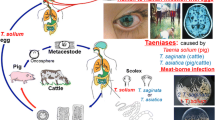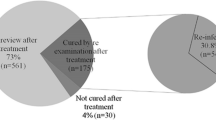Abstract
Clonorchiasis sinensis and Taenia solium taeniasis/cysticercosis are major foodborne parasitoses. Clonorchiasis sinensis is actively transmitted in some areas of China, Korea, Russia, Vietnam, etc. Currently, it is estimated that more than 200 million people are at risk of infection, 15–20 million people are infected, and 1.5–2 million show symptoms or complications. In China, it is relatively heavily transmitted in Zhujiang River Delta, including Hong Kong and Macao, and Northeast China, where many Korean people live. The transmission is related to the unhealthy habits of residents who like to have raw fish or half-raw fish. The infection of Clonorchis sinensis could result in serious liver and biliary system damages, and chronic cases may induce liver and bile duct cancers. T. solium taeniasis/cysticercosis is distributed around the world except the areas where the residents have a taboo against pork for religious reasons. Recent years, the urban inhabitants infected with T. solium/Cysticercus are increasing in China. T. solium results in intestinal diseases, and cysticercosis is a very serious disease, especially nervous system cysticercosis. Its symptoms include headache, epilepsy, sudden death, etc. Health education and health promotion, environmental reconstruction, and chemotherapy are the main control measures for these diseases. Through several decades of efforts in China, the achievements of control of clonorchiasis and T. solium taeniasis/cysticercosis are great. For example, in one of the main clonorchiasis-endemic provinces, Shandong Province, clonorchiasis has been controlled. In 31 T. solium taeniasis/cysticercosis-endemic counties of Henan Province, through a 6-year control program, the decline rates of T. solium taeniasis and cysticercosis were 90.8 and 96.8 %, respectively. This paper reviews the researches on the control of clonorchiasis and T. solium taeniasis/cysticercosis in China past decades so as to provide references for other countries where these diseases are endemic to improve the control or elimination of clonorchiasis and T. solium taeniasis/cysticercosis.
Similar content being viewed by others
References
Chen ZZ, Wu JZ, Lui MZ, Lin D, Pan LX, Yang ZH, Lan X, He JY, Liao YK, Zeng MX, Chen JC, He XJ, Cai SN, Zeng XK, Hu KY LIJQ, Liao YH (1995) Effect of repeated examination and treatment for clonorchis, hookworm, ascaris and trichuris infection control. Chin J Parasit Dis Control 8:211–213
Chen D, Chen J, Huang J, Chen X, Feng D, Liang B, Che Y, Liu X, Zhu C, Li X, Shen H (2010) Epidemiological investigation of Clonorchis sinensis infection in freshwater fishes in the Pearl River Delta. Parasitol Res 107:835–839
Cheng YL, Li QY, Xia CF, Huang JB, Liu XT, Xu L, Li JH (1997) Effect and transmission dynamics of clonorchiasis control in Dianjiang County, Sichuan. J Prac Parsit Dis 5:11–14
Choi MH, Park SK, Li Z, Ji Z, Yu G, Feng Z, Xu L, Cho SY, Rim HJ, Lee SH, Hong ST (2010) Effect of control strategies on prevalence, incidence and re-infection of clonorchiasis in endemic areas of China. PLoS Negl Trop Dis 4:e601
Fang YY, Chen ZZ, Liang NT, Yan CJ, Liu MZ, Zhang QM, Zhang XC, Xie XM (1996) Epidemiological characteristics and control measures of clonorchiasis sinensis in Guizhou, Shunde City. Chin J Schisto Control 8:234–235
Fried B, Abruzzi A (2010) Food-borne trematode infections of humans in the United States of America. Parasitol Res 106:1263–1280
Ge T, Li CH, Yuan S (2004) Comparative investigation on chemotherapy in the control of clonorchiasis. Chin J Parasitol Parasit Dis 22:128
Han CR, Mei SW, Liu F, Li SZ, Ma YX, Wang YZ, Gao GH, Qu MQ (1990) Current status and control of clonorchiasis sinensis in Hanyang County. Chin J Prev Med 24:61
Han GD, Ma YX, Shi GZ, Fang GY, Zhang BG, Li TX, Chang J, Zhao QF, Cui ZL, Wang QZ, Zhang YH (1993) A long-term follow-up of clonorchiasis control on a large scale. Chin J Parasit Dis Control 6:56
Hong ST, Fang Y (2012) Clonorchis sinensis and clonorchiasis, an update. Parasitol Int 61:17–24
Hong ST, Rim HJ, Min DY, Li X, Xu J, Feng Z, Lee SH (2001) Control of clonorchiasis by repeated treatments with praziquantel. Korean J Parasitol 39(4):285–292
Huang XH, Li ZQ, Fang YY, Ruan CY, Zhang XJ, Liu DX, Liang SL (2011) Effect of comprehensive control in demonstration plot of clonorchiasis in Yangshan County, 2006–2009. Chin J Schisto Control 23(569–570):574
Ito A, Urbani C, Jiamin Q, Vuitton DA, Dongchuan Q, Heath DD, Craig PS, Zheng F, Schantz PM (2003) Control of echinococcosis and cysticercosis: a public health challenge to international cooperation in China. Acta Trop 86:3–17
Li Y, Zhao XD, Mu JX, Wang H, Yin GS, Zheng HM, Zhou XH (1998) Study on the efficacy of health education for control of taeniasis and cysticercosis. Chin J Parasit Dis Control 11:29–31
Li W, Kou JX, Wang JX, Liu X, Zhao ZP, Gao CL, Li GP (2000) The role of health education in the control of taeniasis and cysticercosis. Chin Primary Health Care 14:59–60
Li DJ, Deng XL, Zhao ZP, Wen PE, Wan GQ, Liu X, Miao F, Yang GH, Zhang DB, Kou JX, Zhao CL (2007) Study on the control of clonorchiasis sinensis in Shandong Province, China. J Patho Bio 2:360–364
Ning A, Yan X, Jiang WS, Wang LM, Liu HY, Xu XP, Qi AM, Zhou MS, Fu JW, Chen MM, Yang YF, Wang HM, Tan J, Tian MS (1994) Study on the control measures of clonorchiasis. Chin J Parasit Dis Control 7:295–296
Peng CQ, Geng YJ, Huang DN, Gao ST, Li SH, Zhang RL (2010) Evaluation of effectiveness of integrative intervention on Clonorchis sinensis infection in a village of Shenzhen City. Chin Trop Med 10(413–414):430
Raether W, Hänel H (2003) Epidemiology, clinical manifestations and diagnosis of zoonotic cestode infections: an update. Parasitol Res 91:412–438
Song JM, Yang GL (1994) Epidemic characteristics and effect of control of clonorchiasis in Zhouxian County, Shandong Province. Chin J Parasitol Parasit Dis 12:238
Wang ZZ, Yang QY, Chen XG, Xue RY (1983) Control of human Taenia solium taeniasis in Henan Province. Chin J Zoonoses 3:33–35
Xiao SH, Xue J, Xu LL, Zheng Q, Qiang HQ, Zhang YN (2009) The in vitro and in vivo effect of tribendimidine and its metabolites against Clonorchis sinensis. Parasitol Res 105:1497–1507
Xiao SH, Xue J, Li-li X, Zhang YN, Qiang HQ (2010) Effectiveness of mefloquine against Clonorchis sinensis in rats and Paragonimus westermani in dogs. Parasitol Res 107:1391–1397
Xiao SH, Xue J, Xu LL, Zhang YN, Qiang HQ (2011) Comparative effect of mebendazole, albendazole, tribendimidine, and praziquantel in treatment of rats infected with Clonorchis sinensis. Parasitol Res 108:723–730
Yang BX, Chen ZZ, Huo LC, Chen XQ, Zhao XY, Zhang FD, Li ZY, Liu YQ (1994) Investigation on epidemiology of clonorchiasis and discussion of control strategy and measures. Chin J Pub Health 10:303
Zhang R, Gao S, Geng Y, Huang D, Yu L, Zhang S, Cheng J, Fu Y (2007) Epidemiological study on Clonorchis sinensis infection in Shenzhen area of Zhujiang delta in China. Parasitol Res 101:179–183
Zhang QW, Huang FY, Geng YJ, Huang DN, Li XH, Gao ST, Zhang RL (2009) Relationship between propagation of Clonorchis sinensis and ecology cultivation. Chin Trop Med 9(1012–1013):1025
Zhang XC, Pei FQ, Zhang QM, Lin RX, Huang SY, Wang JL, Cen YZ LUWC, Chao B (2010) Current status of environmental sanitation and Clonorchis sinensis intermediate host infection of freshwater aquaculture in partial areas of Guangdong Province. South China J Prev Med 36:9–13
Zhao ZP, Liu X, Wan GQ, Gao CL, Li GP LIW, Deng XL, Li DJ, Chen XX, Xu FQ, Yang BJ, Li JC, Sun QY, Zhang XY, Song XW, Zhang CX, Wang CX, Shi JF, Duan LM, Meng XY, Xia SH (1999) Studies on community control strategies for taeniasis/cysticercosis in Shangdong Province. Chin J Parasit Dis Control 12:111–114
Author information
Authors and Affiliations
Corresponding authors
Additional information
Wei Wu and Xiaohua Qian contributed equally to this work.
Rights and permissions
About this article
Cite this article
Wu, W., Qian, X., Huang, Y. et al. A review of the control of clonorchiasis sinensis and Taenia solium taeniasis/cysticercosis in China. Parasitol Res 111, 1879–1884 (2012). https://doi.org/10.1007/s00436-012-3152-y
Received:
Accepted:
Published:
Issue Date:
DOI: https://doi.org/10.1007/s00436-012-3152-y




